This is an old revision of this page, as edited by Chiswick Chap (talk | contribs) at 09:48, 12 October 2024 (→Species and cultivars: gloss). The present address (URL) is a permanent link to this revision, which may differ significantly from the current revision.
Revision as of 09:48, 12 October 2024 by Chiswick Chap (talk | contribs) (→Species and cultivars: gloss)(diff) ← Previous revision | Latest revision (diff) | Newer revision → (diff) Varieties of peppers of Capsicum genus "Red Chillies" redirects here. For the film, see Red Chillies (film). "Hot pepper" redirects here. For other uses, see Hot pepper (disambiguation). For the dish often called simply "chili", see Chili con carne. For the band, see Red Hot Chili Peppers.

Chili peppers, also spelled chile or chilli (from Classical Nahuatl chīlli Template:IPA-nah), are varieties of the berry-fruit of plants from the genus Capsicum, which are members of the nightshade family Solanaceae, cultivated for their pungency. Chili peppers are widely used in many cuisines as a spice to add "heat" to dishes. Capsaicin and related compounds known as capsaicinoids are the substances that give chili peppers their intensity when ingested or applied topically. Chili peppers exhibit a range of heat and flavors. This diversity is the reason behind the availability of different types of paprika and chili powder, each offering its own taste and heat level.
Chili peppers are believed to have originated in Central or South America and were first cultivated in Mexico. European explorers brought chili peppers back to the Old World in the late 16th century as part of the Columbian Exchange, which led to the cultivation of multiple varieties across the world for food and traditional medicine. Five Capsicum species have been widely cultivated: annuum, baccatum, chinense, frutescens, and pubescens.
In 2019, the world's production of raw green chili peppers amounted to 38 million tons, with China producing half.
History
Origins
Capsicum plants originated in modern-day Peru and Bolivia, and have been a part of human diets since about 7,500 BC. They are one of the oldest cultivated crops in the Americas. Chili peppers were cultivated in east-central Mexico some 6,000 years ago. Chili plants were first cultivated independently across different locations in the Americas including highland Peru and Bolivia, central Mexico, and the Amazon. They were among the first self-pollinating crops cultivated in Mexico, Central America, and parts of South America.
Peru has the highest diversity of cultivated Capsicum; it is a center of diversification where varieties of all five domesticates were introduced, grown, and consumed in pre-Columbian times. The largest diversity of wild Capsicum peppers is consumed in Bolivia. Bolivian consumers distinguish two basic forms: ulupicas, species with small round fruits including C. eximium, C. cardenasii, C. eshbaughii, and C. caballeroi landraces; and arivivis with small elongated fruits including C. baccatum var. baccatum and C. chacoense varieties.

Distribution to Europe
Further information: Columbian exchangeWhen Christopher Columbus and his crew reached the Caribbean, they were the first Europeans to encounter Capsicum fruits. They called them "peppers" because, like black pepper (Piper nigrum), which had long been known in Europe, they have a spicy, hot taste unlike other foods. Chilies were first brought back to Europe by the Spanish, who financed Columbus's voyages, at the start of the large-scale interchange of plants and culture between the New World and the Old World called the Columbian exchange. Chilis appear in Spanish records by 1493. Unlike Piper vines, which grow naturally only in the tropics, chilies could be grown in temperate climates. By the mid-1500s, they had become a common garden plant in Spain and were incorporated into numerous dishes. By 1526, they had appeared in Italy, in 1543 in Germany, and by 1569 in the Balkans, where they came to be processed into paprika.
Distribution to the rest of the world
The rapid introduction of chilis to Africa and Asia was likely through the Portuguese and Spanish traders in the 16th century, though the details are unrecorded. The Portuguese introduced it first to Africa and Arabia, and then to their colonies and trading posts in Asia, including Goa, Sri Lanka, and Malacca. From there, it spread to neighboring regions in South Asia and western Southeast Asia via local trade and natural dispersal. At around the same time, the Spanish also introduced chilis to the Philippines, where it spread to Melanesia, Micronesia, and other Pacific Islands via their monopoly of the Manila galleons. Their spread to East Asia in the late 16th century is less clear, but was likely also through local trade or through Portuguese and Spanish trading ports in Canton, China, and Nagasaki, Japan. The earliest known mention of the chili pepper in Chinese writing dates to 1591, though the pepper is thought to have entered the country in the 1570s.
Producing chili peppers
Cultivation
Chili peppers are the shiny, brightly-coloured fruits of species of Capsicum. Botanically they are berries. The plants are small, 20 to 60 centimetres (7.9 to 23.6 in) depending on variety, making them suitable for growing in pots, greenhouses, or commercially in polytunnels. The plants are perennial, provided they are protected from cold. The fruits can be green, orange, red, or purple, and vary in shape from round and knobbly to smooth and elongated. If the fruits are picked green and unripe, more flowers develop, yielding more fruit; fruits left on the plant can become hotter in taste, and acquire their ripe coloration, at the price of a reduced harvest.
Ideal growing conditions for peppers include a sunny position with warm, loamy soil, ideally 21 to 29 °C (70 to 84 °F), that is moist but not waterlogged. The seeds germinate only when warm, close to 21 °C (70 °F). The plants prefer warm conditions, but can tolerate temperatures down to 12 °C (54 °F); and are sensitive to cold. The flowers can self-pollinate. However, at extremely high temperature, 30 to 38 °C (86 to 100 °F), pollen loses viability, and flowers are much less likely to result in fruit. For flowering, Capsicum is a non-photoperiod-sensitive crop.
Chilies are vulnerable to pests including aphids, glasshouse red spider mite, and glasshouse whitefly, all of which feed on plant sap. Common diseases include grey mould caused by Botrytis cinerea; this rots the tissues and produces a brownish-grey mould on the surface.
- Cultivation
-
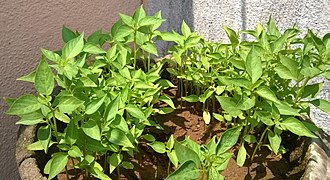 Young plants
Young plants
-
 Buds and flowers
Buds and flowers
-
 Immature chilies in the field
Immature chilies in the field
-
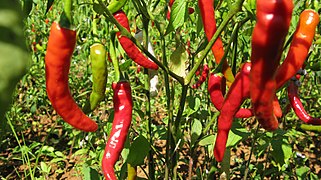 Ripe chilies in the field, Myanmar
Ripe chilies in the field, Myanmar
-
 Leaf damaged by aphids
Leaf damaged by aphids
-
 Ripe chili pepper with seeds
Ripe chili pepper with seeds
Preparation
Harvested chilies may be sold for use fresh, or dried to make a variety of products.
- Drying chilies
-
 Chili peppers drying in Kathmandu, Nepal
Chili peppers drying in Kathmandu, Nepal
-
 Guntur chilli drying in the sun, Andhra Pradesh, India
Guntur chilli drying in the sun, Andhra Pradesh, India
-
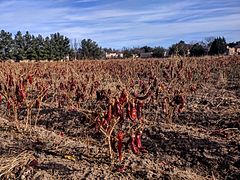 New Mexico chiles dried on the plant in Mesilla, New Mexico
New Mexico chiles dried on the plant in Mesilla, New Mexico
-
 Sundried chili at Imogiri, Yogyakarta, Indonesia
Sundried chili at Imogiri, Yogyakarta, Indonesia
-
 Ristras of chili peppers drying in Arizona
Ristras of chili peppers drying in Arizona
-
Removing seeds and pith from dried chilies in San Pedro Atocpan, Mexico
-
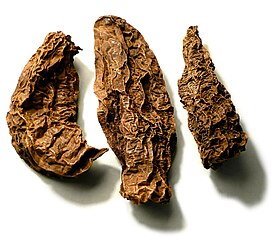 Smoke-dried chipotle
Smoke-dried chipotle
Products include whole dried chilies, chili flakes, chili powder, and chili pepper wine. Whole pods can be dried and then crushed or ground into chili powder and used as a spice or seasoning. Chilies can be dried to prolong their shelf life, or preserved by brining, immersing the pods in oil, or by pickling. Fresh or dried chilies are used to make hot sauce, a liquid condiment—usually bottled when commercially available—that adds spice to other dishes. Hot sauces are found in many cuisines including harissa from North Africa, chili oil from China (known as rāyu in Japan), and sriracha from Thailand. Dried chilies are used to infuse cooking oil.
- Products
-
 Chili pepper wine, Virginia
Chili pepper wine, Virginia
-
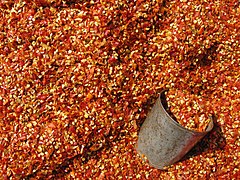 Dried chili pepper flakes, Myanmar
Dried chili pepper flakes, Myanmar
-
 Chili powder, India
Chili powder, India
-
 Brands of hot sauce on sale, California
Brands of hot sauce on sale, California
Annual production
| This section is missing information about FAO data "Chillies and peppers, dry (Capsicum spp., Pimenta spp.), raw". Please expand the section to include this information. Further details may exist on the talk page. (October 2023) |
| Region | (Millions of tons) |
|---|---|
| 16.7 | |
| 2.8 | |
| 2.8 | |
| 2.6 | |
| 1.5 | |
| World | 36.1 |
| Source: FAOSTAT of the United Nations | |
In 2020, 36 million tonnes of green chilies and peppers (counted as any Capsicum or Pimenta fruits) were produced worldwide, with China producing 46% of the total.
Species and cultivars
For a more comprehensive list, see List of Capsicum cultivars.Species of Capsicum that produce chili peppers are shown on the simplified phylogenetic tree, with examples of cultivars:
| Capsicum |
| ||||||||||||||||||||||||||||||||||||
- Cultivars
-
 Cayenne peppers, a cultivar of Capsicum annuum
Cayenne peppers, a cultivar of Capsicum annuum
-
Tabasco peppers, a cultivar of Capsicum frutescens, with fruits pointing upwards
-
 Habanero peppers, a cultivar of the hot species Capsicum chinense
Habanero peppers, a cultivar of the hot species Capsicum chinense
-
 The habanero pepper
The habanero pepper
-
 The Black Pearl cultivar
The Black Pearl cultivar
-
 Cubanelle peppers
Cubanelle peppers
-
 Scotch bonnet chili peppers in a Caribbean market
Scotch bonnet chili peppers in a Caribbean market
-
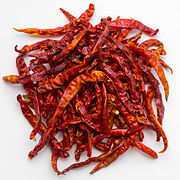 Dried Thai bird's eye chilies
Dried Thai bird's eye chilies
-
 Choricero peppers
Choricero peppers
-
 Peperoncino chili in Tropea, Italy
Peperoncino chili in Tropea, Italy
-
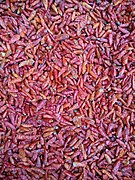 Chili peppers cultivated in Myanmar
Chili peppers cultivated in Myanmar
-
 Green Chillies from North India
Green Chillies from North India
-
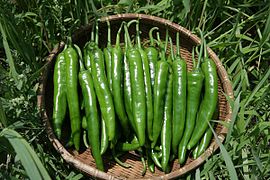 Cheongyang chili pepper from Cheongyang County, South Chungcheong Province, South Korea
Cheongyang chili pepper from Cheongyang County, South Chungcheong Province, South Korea
Intensity
Capsaicin
Main article: Capsaicin Chemical structure
Chemical structure Space-filling modelCapsaicin, the principal molecule that gives chili its heat
Space-filling modelCapsaicin, the principal molecule that gives chili its heat
The substances that give chili peppers their pungency (spicy heat) when ingested or applied topically are capsaicin (8-methyl-N-vanillyl-6-nonenamide) and several related chemicals, collectively called capsaicinoids. The quantity of capsaicin varies by variety, and depends on growing conditions. Water-stressed peppers usually produce stronger pods. When a habanero plant is stressed, by absorbing low water for example, the concentration of capsaicin increases in some parts of the fruit.
When peppers are consumed by mammals such as humans, capsaicin binds with pain receptors in the mouth and throat, potentially evoking pain via spinal relays to the brainstem and thalamus where heat and discomfort are perceived. However, birds are unable to perceive the hotness and so they can eat some of the hottest peppers. The intensity of the "heat" of chili peppers is commonly reported in Scoville heat units (SHU), invented by American pharmacist Wilbur Scoville in 1912. Historically, it was a measure of the dilution of an amount of chili extract added to sugar syrup before its heat becomes undetectable to a panel of tasters; the more it has to be diluted to be undetectable, the more powerful the variety, and therefore the higher the rating. The modern method is a quantitative analysis of SHU using high-performance liquid chromatography to directly measure the capsaicinoid content of a chili pepper variety. Pure capsaicin is a hydrophobic, colorless, odorless, and crystalline-to-waxy solid at room temperature, and measures 16,000,000 SHU.
Capsaicin is produced by the plant as a defense against mammalian predators. A study suggests that by protecting against attack by a hemipteran bug, the risk of disease caused by a Fusarium fungus carried by the insects is reduced. As evidence, the study notes that peppers increased the quantity of capsaicin in proportion to the damage caused by fungi on the plant's seeds.
Intensity range of commonly-used cultivars
A wide range of intensity is found in commonly used peppers:
| Bell pepper | 0 SHU |
| Fresno, jalapeño | 3,500–10,000 SHU |
| Cayenne | 30,000–50,000 SHU |
| Piri piri, bird's eye | 50,000–100,000 SHU |
| Habanero, Scotch bonnet | 100,000–350,000 SHU |
Hottest by country
Further information: Hottest chili pepperThe top 8 world's hottest chili peppers (by country) are:
| Country | Type | Heat (SHU) |
|---|---|---|
| United States | Pepper X | 2.69M |
| Wales | Dragon's Breath | 2.48M* |
| United States | Carolina Reaper | 2.2M |
| Trinidad and Tobago | Trinidad moruga scorpion | 2.0M* |
| India | Ghost pepper (Bhut jolokia) | 1.58M |
| Trinidad and Tobago | Trinidad Scorpion Butch T | 1.46M |
| England | Naga Viper | 1.38M |
| England | Infinity chili | 1.07M |
NOTE: SHU claims marked with an asterisk (*) have not been confirmed by Guinness World Records.
As food
Nutritional value
| Nutritional value per 100 g (3.5 oz) | |||||||||||||||||||||||||||||
|---|---|---|---|---|---|---|---|---|---|---|---|---|---|---|---|---|---|---|---|---|---|---|---|---|---|---|---|---|---|
| Energy | 166 kJ (40 kcal) | ||||||||||||||||||||||||||||
| Carbohydrates | 8.8 g | ||||||||||||||||||||||||||||
| Sugars | 5.3 g | ||||||||||||||||||||||||||||
| Dietary fiber | 1.5 g | ||||||||||||||||||||||||||||
| Fat | 0.4 g | ||||||||||||||||||||||||||||
| Protein | 1.9 g | ||||||||||||||||||||||||||||
| |||||||||||||||||||||||||||||
| Other constituents | Quantity | ||||||||||||||||||||||||||||
| Water | 88 g | ||||||||||||||||||||||||||||
| Capsaicin | 0.01g – 6 g | ||||||||||||||||||||||||||||
Link to USDA Database entry | |||||||||||||||||||||||||||||
| Percentages estimated using US recommendations for adults, except for potassium, which is estimated based on expert recommendation from the National Academies. | |||||||||||||||||||||||||||||
Red hot chili peppers are 88% water, 9% carbohydrates, 2% protein, and 0.4% fat (table). In a 100 gram reference amount, chili peppers supply 40 calories, and are a rich source of vitamin C and vitamin B6 (table).
Pungency
Due to their unique pungency (spicy heat), chili peppers constitute a crucial part of many cuisines around the world, particularly in Chinese (especially in Sichuanese food), Mexican, Thai, Indian, New Mexican cuisine and many other South American, Caribbean and East Asian cuisines. In 21st-century Asian cuisine, chili peppers are commonly used across many regions. Chili is a key ingredient in many curries, providing the desired amount of heat; mild curries may be flavoured with many other spices, and may omit chili altogether.
Cooking the pods
When used fresh, they are most often prepared and eaten like a vegetable. Many fresh chilies such as poblano have a tough outer skin that does not break down on cooking. Chilies are sometimes used whole or in large slices, by roasting, or other means of blistering or charring the skin, so as not to entirely cook the flesh beneath. When cooled, the skins usually slip off easily.
Cooking the leaves
The leaves of every species of Capsicum are edible. Though almost all other Solanaceous crops have toxins in their leaves, chili peppers do not. The leaves, which are mildly bitter and nowhere near as hot as the fruit, are cooked as greens in Filipino cuisine, where they are called dahon ng sili (literally "chili leaves"). They are used in the chicken soup tinola. In Korean cuisine, the leaves may be used in kimchi. In Japanese cuisine, the leaves are cooked as greens, and also cooked in tsukudani style for preservation.
Regional cuisines
Many Mexican dishes, including variations on chiles rellenos, use the entire chili. Dried whole chilies may be reconstituted before grinding to a paste. The chipotle is the smoked, dried, ripe jalapeño. In the northern Mexican states of Sinaloa and Sonora, chiltepin peppers (a wild pepper) are used in cheeses and soups to add spiciness to dishes. In southern Mexico, mole sauce is made with dried chilies, such as ancho and chipotle peppers. Chilies are used in salsas. Mexican households usually grow chili plants to use in cooking.
The Aleppo chili pepper is grown in Syria and Turkey, these peppers are ripened to a burgundy color and then semidried, deseeded, and smashed to a paste, sometimes they are roasted before being soaked to give them a rich flavour.
In India, most households always keep a stock of fresh hot green chilies at hand, and use them to flavor most curries and dry dishes.
Chili is a staple in Bhutan. Bhutanese call this crop ema (in Dzongkha) or solo (in Sharchop). The ema datshi recipe is entirely made of chili mixed with local cheese.
Chilies are present in many cuisines; dishes include arrabbiata sauce, paprikash, chiles en nogada, jerk chicken, mole poblano, nam phrik, 'nduja, sambal, and som tam.
- Dishes
-
 Lamb Madras curry
Lamb Madras curry
-
 Pickled chili in India
Pickled chili in India
-
Chili pepper dip in a traditional restaurant in Amman, Jordan
-
 Filipino tinola chicken soup with labuyo chili leaves
Filipino tinola chicken soup with labuyo chili leaves
Other uses
Ornamental plants

The contrast in color and appearance makes chili plants interesting to some as a purely decorative garden plant.
- Black pearl pepper: small cherry-shaped fruits and dark brown to black leaves
- Black Hungarian pepper: green foliage, highlighted by purple veins and purple flowers, jalapeño-shaped fruits
- Bishop's crown pepper, Christmas bell pepper: named for its distinct three-sided shape resembling a red bishop's crown or a red Christmas bell
Constrained risk-taking
Psychologist Paul Rozin suggests that eating chilies is an example of a "constrained risk" like riding a roller coaster, in which extreme sensations like pain and fear can be enjoyed because individuals know that these sensations are not actually harmful. This method lets people experience extreme feelings without any significant risk of bodily harm.
Topical use and health research
Capsaicin, the pungent chemical in chili peppers, is used as an analgesic in topical ointments, nasal sprays, and dermal patches to relieve pain. A 2022 review of preliminary research indicated that regular consumption of chili peppers was associated with weak evidence for a lower risk of death from cardiovascular diseases and cancer.
Chemical irritants
Further information: Pepper spray and Chili grenadeCapsaicin extracted from chilies is used in pepper sprays and some tear gas formulations as a chemical irritant, for use as less-lethal weapons for control of unruly individuals or crowds. Such products have considerable potential for misuse, and may cause injury or death.
Conflicts between farmers and elephants have long been widespread in African and Asian countries, where elephants nightly destroy crops, raid grain houses, and sometimes kill people. Farmers have found the use of chilies effective in crop defense against elephants. Elephants do not like capsaicin. Because the elephants have a large and sensitive olfactory and nasal system, the smell of the chili causes them discomfort and deters them from feeding on the crops. By planting a few rows of the fruit around valuable crops, farmers create a buffer zone through which the elephants are reluctant to pass. Chili dung bombs are also used for this purpose. They are bricks made of mixing dung and chili, and are burned, creating a noxious smoke that keeps hungry elephants out of farmers' fields. This can lessen dangerous physical confrontation between people and elephants.
Birds do not have the same sensitivity to capsaicin as mammals, as they lack a specific pain receptor. Chili peppers are eaten by birds living in the chili peppers' natural range, possibly contributing to seed dispersal and evolution of the protective capsaicin in chili peppers, as a bird in flight can spread the seeds further away from the parent plant after they pass through its digestive system than any land or tree dwelling mammal could do so under the same circumstances, thus reducing competition for resources.
Etymology and spelling
The English word is from from Classical Nahuatl chīlli with the same meaning. The name of the plant is unrelated to that of the country Chile. While pepper originally meant the genus Piper, not Capsicum, the Oxford English Dictionary and Merriam-Webster record both usages.
The three primary spellings are chili, chile and chilli, all recognized by dictionaries.
- Chili is widely used in English of the United States and optionally in Canada.
- Chile is the most common Spanish spelling in Mexico and several other Latin American countries, and some parts of the United States.
- Chilli was the original Romanization of the Náhuatl language word for the fruit (chilli) and is the preferred British spelling according to the Oxford English Dictionary. Chilli (and its plural chillies) is the most common spelling in former British colonies such as India and Sri Lanka.
Safety
The volatile oil in spicy peppers may cause skin irritation, requiring hand washing and care when touching the eyes or any sensitive body parts. Consuming hot peppers may cause stomach pain, hyperventilation, sweating, vomiting, and symptoms possibly requiring hospitalization.
See also
- Food and drink prohibitions – which in some cultures includes chili peppers
- Hatch, New Mexico – known as the "Chile Capital of the World"
- History of chocolate – which the Maya drank with ground chili peppers
- International Connoisseurs of Green and Red Chile – organization for the promotion of chili peppers
- Peppersoup
- Salsa (sauce)
- Sweet chili sauce – a condiment for adding a sweet, mild heat taste to food
References
- Dasgupta, R. R. (8 May 2011). "Indian chilli displacing jalapenos in global cuisine". The Economic Times.
- "HORT410. Peppers – Notes". Purdue University Department of Horticulture and Landscape Architecture. Archived from the original on 26 December 2018. Retrieved 20 October 2009.
Common name: pepper. Latin name: Capsicum annuum L. ... Harvested organ: fruit. Fruit varies substantially in shape, pericarp thickness, color and pungency.
- peppergeek (28 September 2022). "Paprika vs. Chili Powder vs. Cayenne: What's The Difference?". Pepper Geek. Retrieved 19 September 2023.
- Mishan, Ligaya (18 August 2022). "How The Chili Became Hot". The New York Times. Retrieved 1 October 2022.
- ^ Pickersgill B (December 1971). "Relationships Between Weedy and Cultivated Forms in Some Species of Chili Peppers (Genus Capsicum)". Evolution; International Journal of Organic Evolution. 25 (4): 683–691. doi:10.1111/j.1558-5646.1971.tb01926.x. PMID 28564789. S2CID 205772121.
- ^ Katherine C, Christine H (16 December 2014). "A Systematic Approach to Species-Level Identification of Chile Pepper (Capsicum spp.) Seeds: Establishing the Groundwork for Tracking the Domestication and Movement of Chile Peppers through the Americas and Beyond". Economic Botany. 68 (3). New York Botanical Garden Press: 316–336. Bibcode:2014EcBot..68..316C. doi:10.1007/s12231-014-9279-2. JSTOR 43305668. S2CID 36556206. Retrieved 11 February 2022.
- ^ Kraft KH, Brown CH, Nabhan GP, Luedeling E, Luna Ruiz J, Coppens d'Eeckenbrugge G, et al. (April 2014). "Multiple lines of evidence for the origin of domesticated chili pepper, Capsicum annuum, in Mexico". Proceedings of the National Academy of Sciences of the United States of America. 111 (17): 6165–6170. Bibcode:2014PNAS..111.6165K. doi:10.1073/pnas.1308933111. PMC 4035960. PMID 24753581.
- "Green chili production in 2019; Crops/World Regions/Production Quantity/Green Chillies and Peppers from pick lists". UN Food and Agriculture Organization, Statistics Division (FAOSTAT). 2021. Retrieved 12 December 2021.
- ^ Bosland PW (1998). "Capsicums: Innovative uses of an ancient crop". In Janick J (ed.). Progress in New Crops. Arlington, VA: ASHS Press. pp. 479–487. Retrieved 23 December 2010.
- "Birthplace of the domesticated chili pepper identified in Mexico". EurekaAlert, American Association for the Advancement of Science. 21 April 2014.
- Carrizo García, Carolina; Barfuss, Michael H. J.; Sehr, Eva M.; Barboza, Gloria E.; Samuel, Rosabelle; Moscone, Eduardo A.; Ehrendorfer, Friedrich (July 2016). "Phylogenetic relationships, diversification and expansion of chili peppers ( Capsicum, Solanaceae)". Annals of Botany. 118 (1): 35–51. doi:10.1093/aob/mcw079. ISSN 0305-7364. PMC 4934398. PMID 27245634.
- ^ van Zonneveld M, Ramirez M, Williams DE, Petz M, Meckelmann S, Avila T, et al. (2015). "Screening Genetic Resources of Capsicum Peppers in Their Primary Center of Diversity in Bolivia and Peru". PLOS ONE. 10 (9): e0134663. Bibcode:2015PLoSO..1034663V. doi:10.1371/journal.pone.0134663. PMC 4581705. PMID 26402618.
- Bosland PW, Votava E (2000). Peppers: Vegetable and Spice Capsicums. New York City: CABI. p. 1. ISBN 9780851993355. Retrieved 29 November 2018.
- "The Story of Chile Peppers". New Mexico State University Chile Pepper Institute. Retrieved 7 August 2024.
- Sauer, Jonathan D. (2017). Historical Geography of Crop Plants A Select Roster. CRC Press. p. 161. ISBN 9781351440622.
- Raghavan, Susheela (2006). Handbook of Spices, Seasonings, and Flavorings. CRC Press. p. 8. ISBN 9781420004366.
- Wallin, Nils-Bertil (11 June 2004). "Chili: Small Fruit Sets Global Palettes on Fire". YaleGlobal Online. Yale University. Retrieved 5 January 2024.
- DeWitt, Dave (2020). Chile Peppers A Global History. University of New Mexico Press. ISBN 9780826361806.
- Collingham E (February 2006). Curry. Oxford University Press. ISBN 978-0-09-943786-4.
- Raj NM, Peter KV, Nybe EV (1 January 2007). Spices. New India Publishing. pp. 107–. ISBN 978-81-89422-44-8.
- Dott BR (2020). The Chile Pepper in China. Columbia University Press. p. 21. ISBN 9780231551304.
The earliest known record for chiles in a Chinese source is from Hangzhou, Zhejiang, in 1591
- ^ "How to grow chilli pepper / RHS Gardening".
- "Growing Peppers: The Important Facts". GardenersGardening.com. Archived from the original on 27 January 2013. Retrieved 10 January 2013.
- "The Effect of Extreme Temperatures on the Tomato and Pepper Crop". King’s Printer for Ontario, 2012–24, Canada.
- Hui, Y. H., ed. (2005). Handbook of Food Science, Technology, and Engineering. Taylor & Francis. pp. 20–13. ISBN 978-1-4665-0787-6.
- ^ "Green chili production in 2020; Crops/World Regions/Production Quantity/Green Chillies and Peppers from pick lists". UN Food and Agriculture Organization, Statistics Division (FAOSTAT). 2022. Retrieved 17 May 2022.
- Shiragaki, Kumpei; Yokoi, Shuji; Tezuka, Takahiro (20 November 2020). "Phylogenetic Analysis and Molecular Diversity of Capsicum Based on rDNA-ITS Region". Horticulturae. 6 (4): 87. doi:10.3390/horticulturae6040087.
- Normah MN, Chin HF, Reed BM (2013). Conservation of tropical plant species. New York: Springer. p. 397. ISBN 9781461437758. Retrieved 28 November 2018.
- ^ Kosuge S, Inagaki Y, Okumura H (1961). "Studies on the pungent principles of red pepper. Part VIII. On the chemical constitutions of the pungent principles". Nippon Nogeikagaku Kaishi. 35: 923–927. doi:10.1271/nogeikagaku1924.35.10_923. Chem. Abstr. 1964, 60, 9827g.
- Kosuge S, Inagaki Y (1962). "Studies on the pungent principles of red pepper. Part XI. Determination and contents of the two pungent". J. Agric. Chem. Soc. Japan (in Japanese). 36: 251–254.
- Ruiz-Lau N, Medina-Lara F, Minero-García Y, Zamudio-Moreno E, Guzmán-Antonio A, Echevarría-Machado I, Martínez-Estévez M (1 March 2011). "Water Deficit Affects the Accumulation of Capsaicinoids in Fruits of Capsicum chinense Jacq". HortScience. 46 (3): 487–492. doi:10.21273/HORTSCI.46.3.487.
- O'Neill J, Brock C, Olesen AE, Andresen T, Nilsson M, Dickenson AH (October 2012). "Unravelling the mystery of capsaicin: a tool to understand and treat pain". Pharmacological Reviews. 64 (4): 939–971. doi:10.1124/pr.112.006163. PMC 3462993. PMID 23023032.
- "History of the Scoville Scale | FAQS". Tabasco.Com. Archived from the original on 23 August 2010. Retrieved 23 December 2010.
- ^ Tewksbury JJ, Reagan KM, Machnicki NJ, Carlo TA, Haak DC, Peñaloza AL, Levey DJ (August 2008). "Evolutionary ecology of pungency in wild chilies". Proceedings of the National Academy of Sciences of the United States of America. 105 (33): 11808–11811. Bibcode:2008PNAS..10511808T. doi:10.1073/pnas.0802691105. PMC 2575311. PMID 18695236.
- Filippone PT (11 October 2000). "Chile Pepper Heat Scoville Scale". Homecooking.about.com. Archived from the original on 26 February 2012. Retrieved 14 April 2013.
- Atwal S (16 October 2023). "Pepper X dethrones Carolina Reaper as world's hottest chilli pepper". Guinness World Records. Retrieved 16 October 2023.
- Morris L (22 January 2018). "The Hottest Chilli in the World was Created in Wales Accidentally". National Geographic. Archived from the original on 18 February 2018. Retrieved 17 February 2018.
- Lynch K (19 November 2013). "Confirmed: Smokin Ed's Carolina Reaper sets new record for hottest chilli". Guinness World Records. Retrieved 8 November 2014.
- Bryan SM (16 February 2012). "Trinidad Moruga Scorpion wins hottest pepper title". Yahoo! News. Associated Press. Archived from the original on 1 April 2012. Retrieved 11 May 2013.
- Joshi M (11 March 2012). "Chile Pepper Institute studies what's hot". Your life. USA Today. Archived from the original on 14 March 2012.
- Da Silva M (12 April 2011). "Aussies grow world's hottest chilli". Australian Geographic. Archived from the original on 28 October 2011. Retrieved 12 April 2011.
- "Title of world's hottest chili pepper stolen – again". The Independent. London. 25 February 2011. Retrieved 27 February 2011.
- Henderson N (19 February 2011). ""Record-breaking" chilli is hot news". BBC News. Retrieved 20 February 2011.
- "Home". Guinness World Records.
- United States Food and Drug Administration (2024). "Daily Value on the Nutrition and Supplement Facts Labels". FDA. Archived from the original on 27 March 2024. Retrieved 28 March 2024.
- National Academies of Sciences, Engineering, and Medicine; Health and Medicine Division; Food and Nutrition Board; Committee to Review the Dietary Reference Intakes for Sodium and Potassium (2019). "Chapter 4: Potassium: Dietary Reference Intakes for Adequacy". In Oria, Maria; Harrison, Meghan; Stallings, Virginia A. (eds.). Dietary Reference Intakes for Sodium and Potassium. The National Academies Collection: Reports funded by National Institutes of Health. Washington, DC: National Academies Press (US). pp. 120–121. doi:10.17226/25353. ISBN 978-0-309-48834-1. PMID 30844154. Retrieved 5 December 2024.
- Link to USDA Database entry
- Robinson S (14 June 2007). "Chili Peppers: Global Warming". Time. Retrieved 25 May 2019.
- McQuaid J (20 February 2015). "What's driving the global chili pepper craze?". Forbes Media. Retrieved 25 May 2019.
- Jaffrey, Madhur (1982). Madhur Jaffrey's Indian Cookery. BBC. pp. 7–10. ISBN 978-0-563-16491-3.
- "Dahon ng Sili (Chili pepper leaves)". Tribo ความสุขบนเตียง. Archived from the original on 12 March 2007.
- "Vitamin Rich Chili pepper Leaf Kimchi". Ssoft International Corporation. Archived from the original on 14 November 2009.
- Basan, Ghillie (2006). Middle Eastern Kitchen. Hippocrene Books. ISBN 978-0-7818-1190-3.
- Dietz, S. Theresa (11 October 2022). The Complete Language of Food: A Definitive and Illustrated History. Wellfleet Press. ISBN 978-1-57715-259-0.
- Bosland, Paul W.; Hamilton, Wendy V. (15 March 2023). The Official Cookbook of the Chile Pepper Institute. University of New Mexico Press. ISBN 978-0-8263-6456-2.
- "New Ornamental Pepper Wins Prestigious Award". The United States National Arboretum. 2006. Retrieved 11 October 2024.
- "Chilies as Ornamental Plants". Seedsbydesign. Archived from the original on 15 May 2013.
- "Bishop's crown pepper". CayenneDiane.com.
- Rozin P, Schiller D (1980). "The Nature and Acquisition of a Preference for Chili Pepper by Humans". Motivation and Emotion. 4 (1): 77–101. doi:10.1007/BF00995932. S2CID 143848453.
- Fattori V, Hohmann MS, Rossaneis AC, Pinho-Ribeiro FA, Verri WA (June 2016). "Capsaicin: Current Understanding of Its Mechanisms and Therapy of Pain and Other Pre-Clinical and Clinical Uses". Molecules. 21 (7): 844. doi:10.3390/molecules21070844. PMC 6273101. PMID 27367653.
- Kaur M, Verma BR, Zhou L, Lak HM, Kaur S, Sammour YM, et al. (March 2022). "Association of pepper intake with all-cause and specific cause mortality - A systematic review and meta-analysis". American Journal of Preventive Cardiology. 9: 100301. doi:10.1016/j.ajpc.2021.100301. PMC 8688560. PMID 34977833.
- ^ Haar RJ, Iacopino V, Ranadive N, Weiser SD, Dandu M (October 2017). "Health impacts of chemical irritants used for crowd control: a systematic review of the injuries and deaths caused by tear gas and pepper spray". BMC Public Health. 17 (1): 831. doi:10.1186/s12889-017-4814-6. PMC 5649076. PMID 29052530.
- Mott M. "Elephant Crop Raids Foiled by Chili Peppers, Africa Project Finds". National Geographic. Archived from the original on 29 October 2013. Retrieved 23 October 2013.
- Tewksbury JJ, Nabhan GP (July 2001). "Seed dispersal. Directed deterrence by capsaicin in chilies". Nature. 412 (6845): 403–404. doi:10.1038/35086653. PMID 11473305. S2CID 4389051.
- "chili (n.)". Online Etymology Dictionary. Retrieved 11 October 2024.
- ^ "Chilli, chilly". Oxford English Dictionary. Vol. 2 C (1 Corrected re-issue ed.). Oxford, UK. 1933. p. 346. Retrieved 19 July 2021.
{{cite encyclopedia}}: CS1 maint: location missing publisher (link) - "Pepper". OED. Vol. 7 N–Poy (1 Corrected re-issue ed.). Oxford, UK. 1913. p. 663. Retrieved 19 July 2021.
{{cite encyclopedia}}: CS1 maint: location missing publisher (link) (sense 2b of pepper) - "pepper". Merriam-Webster.com Dictionary. Merriam-Webster. Retrieved 21 July 2021.
- "Chili". Merriam-Webster.com Dictionary. Merriam-Webster. Retrieved 21 July 2021.
- The Canadian Oxford Dictionary lists chili as the main entry.
- Heiser C (August 1990). Seed To Civilization: The Story of Food. Cambridge: Harvard University Press. ISBN 978-0-674-79681-2.
- "chile". Merriam-Webster.com Dictionary. Merriam-Webster. Retrieved 21 July 2021.
- Usage example: "Fall in exports crushes chilli prices in Guntur". Thehindubusinessline.com. Retrieved 21 April 2012.
- Usage example: "Chilli, Capsicum and Pepper are spicy plants grown for the pod. Green chilli is a culinary requirement in any Sri Lankan household". The Sunday Times. Retrieved 21 April 2012.
- Beck A (8 May 2019). "How to Handle Hot Peppers and Chiles Safely". Better Homes and Gardens. Retrieved 23 July 2022.
- Goldfrank LR, ed. (23 March 2007). Goldfrank's Toxicologic Emergencies. New York, New York: McGraw-Hill. p. 1167. ISBN 978-0-07-144310-4.
External links
- Plant Cultures: Chilli pepper botany, history and uses
- The Chile Pepper Institute of New Mexico State University
- Capsicums: Innovative Uses of an Ancient Crop
- Chilli: La especia del Nuevo Mundo (Article from Germán Octavio López Riquelme about biology, nutrition, culture and medical topics. In Spanish)
- The Hot Pepper List List of chili pepper varieties ordered by heat rating in Scoville Heat Units (SHU)
| Capsicum cultivars | |
|---|---|
| C. annuum var. annuum |
|
| C. annuum var. glabriusculum | |
| C. chinense | |
| C. frutescens | |
| C. baccatum | |
| C. pubescens | |
| Culinary herbs and spices | |
|---|---|
| Herbs |
|
| Spices |
|
| Blends |
|
| Lists |
|
| Related topics | |
- Agriculture in Mesoamerica
- Chili peppers
- Medicinal plants of Central America
- Medicinal plants of South America
- Crops originating from Ecuador
- Crops originating from Mexico
- Crops originating from Peru
- Symbols of New Mexico
- Leaf vegetables
- New Mexican cuisine
- Cuisine of the Southwestern United States
- Crops originating from the Americas
- Indian spices
- Crops
- Sri Lankan spices
- Mesoamerican cuisine
- Mexican cuisine
- Fruits originating in North America
